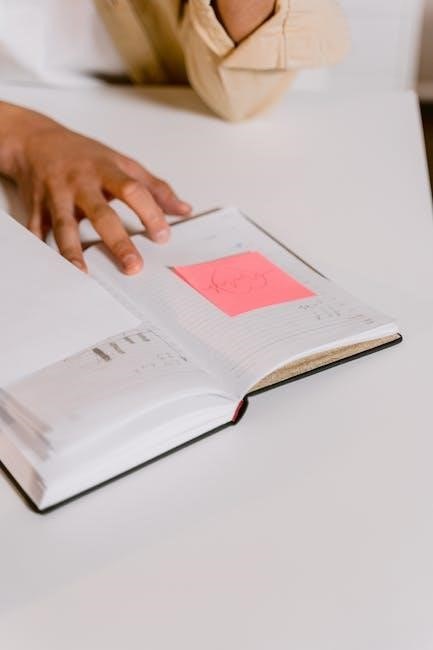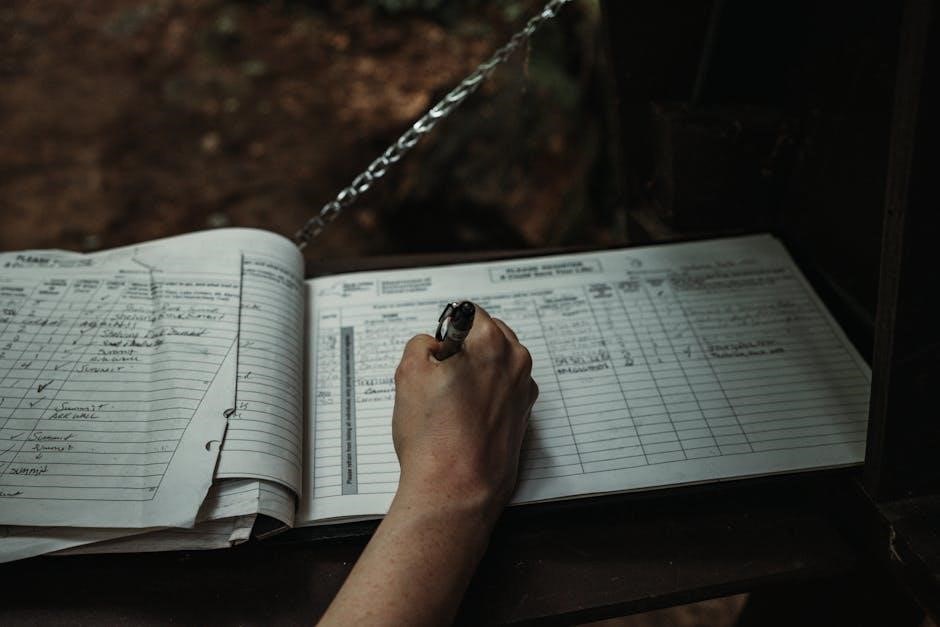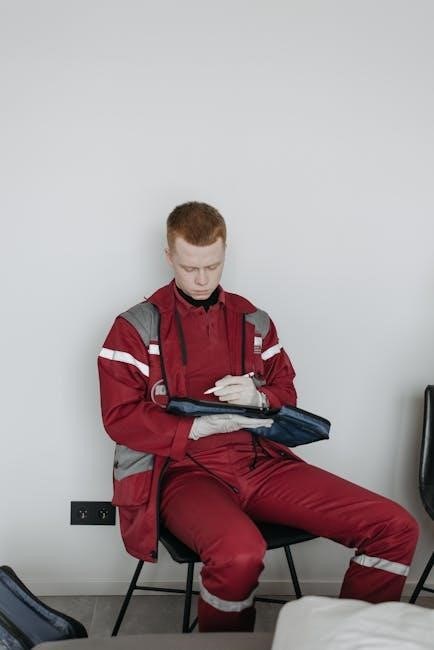SOAP notes (Subjective, Objective, Assessment, Plan) are a standardized method of documentation in occupational therapy, ensuring clear and structured communication of patient care and progress.
1.1 What are SOAP Notes?
SOAP notes are a structured documentation method used in occupational therapy, consisting of four sections: Subjective, Objective, Assessment, and Plan. They provide a clear and organized way to record patient information, progress, and treatment plans. Each section serves a specific purpose, ensuring comprehensive communication of client care and facilitating legal compliance, billing, and continuity of services.
1.2 Importance of SOAP Notes in OT
SOAP notes are vital in occupational therapy (OT) for legal compliance, billing, and continuity of care. They ensure accurate documentation of client progress, treatment plans, and outcomes, supporting reimbursement and accountability. By standardizing documentation, SOAP notes enhance communication among healthcare providers, aligning interventions with client goals and promoting ethical practice. They also serve as a legal record, protecting both clients and practitioners.
Structure of SOAP Notes
SOAP notes consist of four sections: Subjective (client-reported info), Objective (observable data), Assessment (professional interpretation), and Plan (interventions and goals), ensuring comprehensive documentation of client care.

2.1 Subjective (S)
The Subjective section captures client-reported information, including feelings, concerns, and history. It documents the client’s perspective, providing context for their condition and treatment goals. This section is essential for understanding the client’s experience and informing the assessment and plan. It should be concise, clear, and focused on relevant details that impact occupational performance and therapy outcomes.
2.2 Objective (O)
The Objective section documents measurable and observable data, such as test results, observations, and client performance during sessions. This section provides factual information gathered through evaluations, assessments, and treatment activities. It includes quantitative measures like range of motion, strength, or cognitive assessments. The Objective section is crucial for tracking progress and ensuring accountability, as it forms the foundation for the Assessment and Plan sections of the SOAP note.
2.3 Assessment (A)
The Assessment section interprets the data from the Subjective and Objective sections, identifying the client’s strengths, limitations, and progress. It links findings to occupational performance and participation. This section requires clinical reasoning to analyze the client’s status and determine the effectiveness of interventions. The Assessment serves as the foundation for the Plan, guiding future interventions and goal adjustments. It is where the occupational therapist’s expertise shines, connecting data to meaningful outcomes.
2.4 Plan (P)
The Plan outlines specific interventions, treatment goals, and expected outcomes. It details actionable strategies and therapeutic activities to address identified issues. This section ensures continuity of care, guiding future sessions and measuring progress. The Plan must be clear, measurable, and aligned with the client’s needs and assessment findings, ensuring effective and targeted interventions for optimal outcomes.

Legal, Ethical, and Reimbursement Considerations
SOAP notes must comply with HIPAA standards, ensuring patient confidentiality. Accurate documentation is crucial for legal protection and reimbursement, adhering to ethical and professional standards in occupational therapy.
3.1 HIPAA Compliance
HIPAA compliance is essential in occupational therapy documentation to protect patient confidentiality. SOAP notes must adhere to strict guidelines, ensuring sensitive information is securely stored and transmitted. Breaches can result in legal penalties, emphasizing the importance of proper documentation practices. HIPAA standards ensure that patient data remains confidential while allowing necessary sharing for treatment and billing purposes, maintaining trust and legal integrity in healthcare settings.
3.2 Reimbursement and Billing
Accurate SOAP notes are crucial for reimbursement and billing in occupational therapy. Detailed documentation ensures services are justified and billed correctly, adhering to insurance requirements. Proper coding and clear documentation prevent payment delays or denials. HIPAA-compliant records also support secure billing processes. Effective SOAP notes help practitioners demonstrate medical necessity, ensuring timely reimbursement and maintaining fiscal integrity in clinical practice.
Guidelines for Effective Documentation
Clear examples, step-by-step instructions, and templates guide occupational therapists in creating concise, professional SOAP notes. Worksheets and learning activities enhance documentation skills, ensuring accuracy and completeness.
4.1 Conciseness and Clarity
SOAP notes must be concise and clear to ensure effective communication. Avoid unnecessary details, focusing on relevant information. Use professional language and avoid jargon. Templates and examples help maintain clarity, ensuring documentation is precise and easy to understand. Conciseness prevents overwhelming readers while clarity ensures accurate interpretation of patient progress and plans.
4.2 Professional Language
Using professional language in SOAP notes ensures clarity and respect for patient care. Avoid slang, jargon, and informal terms. Maintain a formal tone while being concise. Proper terminology reflects expertise and adheres to legal standards. Clear communication enhances readability for other healthcare professionals, ensuring accurate interpretation of patient progress and treatment plans. Professional language also supports reimbursement and legal requirements, making it a cornerstone of effective documentation in occupational therapy practice.

Occupation-Based Problem Statements
Occupation-based problem statements identify specific issues impacting a patient’s daily tasks and activities. They are client-centered, focusing on limitations in occupational performance and guiding assessment and treatment plans effectively.
5.1 Defining Occupational Problems
Occupational problems are limitations in performing daily tasks, impacting a client’s ability to engage in meaningful activities. These issues are identified through assessment and client feedback, focusing on deficits in activities of daily living (ADLs), work, or leisure. Clear definition ensures targeted interventions, aligning treatment with the client’s goals and promoting functional independence. Accurate identification is crucial for effective documentation and treatment planning in occupational therapy practice.
5.2 Examples and Templates
SOAP note templates provide structured formats for documenting client care, ensuring consistency and completeness. Examples include occupation-based problem statements and measurable goals, guiding clear communication of treatment plans. Worksheets and checklists are often included to help practitioners organize their notes effectively. These tools promote accuracy and efficiency, especially for students and new professionals learning to document occupational therapy interventions and client progress systematically.

Writing Measurable Goals and Objectives
Measurable goals in SOAP notes are specific, achievable, and time-bound, aligning with SMART criteria to guide interventions and track client progress effectively in occupational therapy.
6.1 SMART Goals
SMART goals in occupational therapy are Specific, Measurable, Achievable, Relevant, and Time-bound, ensuring clear objectives for client progress. They guide interventions, track outcomes, and enhance accountability. Using SMART criteria in SOAP notes aligns goals with assessments, promoting effective documentation and reimbursement. Examples and templates in the manual help therapists craft actionable plans, fostering better client outcomes and structured care.
6.2 Aligning Goals with Assessment
Aligning goals with assessment ensures objectives are tailored to the client’s needs and abilities. This process involves using assessment data to inform measurable, achievable, and relevant goals. The manual provides examples and templates to guide therapists in creating goals that directly address identified issues. Proper alignment supports effective treatment planning, progress tracking, and reimbursement, ensuring documentation reflects client-centered care and outcomes.
Intervention Planning
Intervention planning outlines specific strategies and activities to address client needs, ensuring alignment with goals and documentation of progress for effective occupational therapy practice.
7.1 Strategies and Activities
Strategies and activities in intervention planning are tailored to address specific client needs, using evidence-based practices to promote occupational performance. These interventions may include adaptive techniques, assistive devices, or therapeutic exercises. Activities are designed to enhance motor skills, daily living tasks, or cognitive abilities, aligning with measurable goals; Documentation ensures progress tracking and accountability, reflecting the client’s response to interventions and informing future treatment adjustments.
7.2 Documenting Progress
Documenting progress in SOAP notes involves tracking client advancements toward goals, noting changes in functional abilities, and recording any challenges faced. This section provides a clear timeline of improvements, helping to refine treatment plans and ensure continuity of care. Accurate documentation also supports reimbursement and legal requirements, maintaining accountability and transparency in the therapeutic process.
Documenting Different Stages of Service Delivery
SOAP notes document initial evaluations, ongoing treatment, and discharge planning, ensuring continuity of care and clear communication of client progress across all service delivery stages.
8.1 Initial Evaluation
The initial evaluation stage in SOAP notes captures baseline client information, including medical history, occupational performance, and initial goals. This section documents the client’s condition at the start of therapy, providing a foundation for future progress tracking. It includes observations, assessments, and initial impressions, ensuring a clear starting point for treatment planning and documentation. This step is crucial for establishing a client-centered approach and setting measurable objectives.
8.2 Ongoing Treatment
Ongoing treatment documentation in SOAP notes tracks client progress, updates goals, and reflects adjustments to the intervention plan. This section records therapeutic activities, client responses, and any changes in condition. It ensures continuity of care by detailing modifications to treatment strategies based on client feedback and observed outcomes, maintaining a clear record of progress toward established objectives.
8.3 Discharge Planning
Discharge planning in SOAP notes outlines the transition of clients from active treatment to independence or alternative care. It summarizes progress, identifies remaining goals, and provides instructions for continued care. This section ensures a smooth transition by documenting home exercises, referrals, and follow-up appointments, while also addressing any remaining limitations or needs for future support.
Different Practice Settings
SOAP notes are adaptable across various occupational therapy settings, including pediatric, adult, and specialized environments, ensuring consistent documentation regardless of the practice context or client population.
9.1 Pediatric vs. Adult Settings
SOAP notes in pediatric settings focus on developmental milestones and parental collaboration, while adult settings emphasize functional independence and workplace adaptations. Both require tailored documentation to address specific client needs, ensuring interventions align with individual goals and environments. The structure remains consistent, but content adapts to age-specific challenges, making SOAP notes versatile for diverse practice contexts.
9.2 Specialized Settings
SOAP notes adapt to specialized settings like schools, hospitals, or rehabilitation centers, ensuring documentation aligns with unique client needs. In mental health, notes focus on emotional well-being, while in geriatric care, they emphasize functional maintenance. Each setting requires tailored documentation to reflect specific interventions and goals, ensuring continuity of care and clear communication among healthcare providers.

Electronic Documentation
Electronic documentation, particularly through EHR systems, enhances efficiency and accessibility in occupational therapy. It streamlines SOAP note creation, improves data security, and ensures compliance with regulations.
10.1 EHR Systems
Electronic Health Record (EHR) systems are integral to modern occupational therapy documentation, offering structured templates for SOAP notes and real-time access to patient data. These systems enhance accuracy, reduce errors, and ensure HIPAA compliance. EHRs streamline documentation processes, improve communication among healthcare providers, and support reimbursement by maintaining detailed, organized records. They also allow for customization, making it easier to adapt SOAP notes to specific patient needs and practice settings.
10.2 Advantages and Challenges
EHR systems offer numerous advantages, including improved accuracy, efficiency, and compliance with legal standards. They enable quick access to patient histories and facilitate seamless communication among healthcare providers. However, challenges such as the steep learning curve, high implementation costs, and potential for documentation burnout exist. Additionally, reliance on technology can sometimes hinder the therapeutic relationship, emphasizing the need for a balanced approach in using EHR systems for SOAP note documentation.
SOAP notes are a cornerstone of occupational therapy documentation, providing a structured format to capture patient care effectively. This manual offers essential tools and updated content for OT students and practitioners, ensuring clear and concise documentation. It includes examples, templates, and guidelines to master SOAP note writing, aligning with legal and ethical standards. The resource emphasizes the importance of accurate documentation for reimbursement, client care, and professional practice, making it indispensable for occupational therapy professionals.

Structure
SOAP notes follow a structured format: Subjective, Objective, Assessment, and Plan. Each section serves a distinct purpose, ensuring comprehensive documentation. Subjective captures client-reported information, while Objective includes measurable data. Assessment synthesizes findings, and Plan outlines interventions. This clear framework aids in organizing patient care, facilitating communication, and maintaining accountability in occupational therapy practice.

Legal
SOAP notes must comply with legal standards, including HIPAA regulations, to protect patient confidentiality. Accurate documentation ensures adherence to ethical guidelines and supports reimbursement claims. Proper documentation also serves as a legal record of care provided, safeguarding both clients and practitioners. Understanding these legal requirements is essential for maintaining professional integrity and avoiding potential liabilities in occupational therapy practice.
Guidelines
Effective SOAP note documentation requires clear, concise, and professional language. Use specific, measurable terms to describe observations and goals. Maintain client confidentiality and adhere to HIPAA standards. Regularly review and update notes to reflect progress and changes in treatment plans. Utilize templates and checklists to ensure consistency and completeness in documentation, fostering accurate and reliable communication of patient care and outcomes in occupational therapy practice.

Problem Statements
Occupation-based problem statements identify barriers to daily activities and participation. They link assessment findings to treatment plans, focusing on client-centered goals. Use clear, professional language and include specific examples to illustrate limitations. Templates and worksheets guide the creation of structured statements, ensuring alignment with client needs and promoting effective intervention planning in occupational therapy practice.
Goals
Occupational therapy goals are client-centered and occupation-based, focusing on improving daily activities and participation; Use SMART criteria (Specific, Measurable, Achievable, Relevant, Time-bound) to ensure clarity and effectiveness. Align goals with assessment findings and treatment plans, reflecting the client’s priorities and functional needs. Templates and examples guide the creation of clear, actionable objectives, ensuring progress can be tracked and documented effectively in SOAP notes.
Intervention
Intervention in occupational therapy involves tailored strategies and activities to address client needs and promote participation in daily activities. Therapists use evidence-based methods to implement treatment plans, focusing on skill development, adaptation, or compensation. Documentation of interventions in SOAP notes ensures clarity and accountability, tracking progress toward goals. This systematic approach supports client-centered care and measurable outcomes across various practice settings.

Practice Settings
Occupational therapy is practiced in diverse settings, including pediatric, adult, and specialized environments. SOAP notes adapt to each context, ensuring consistent documentation. In pediatric settings, notes focus on developmental goals, while adult settings emphasize functional independence. Specialized settings, like rehabilitation centers, require detailed intervention plans. Effective documentation across all settings ensures continuity of care and supports reimbursement, making SOAP notes a versatile tool for occupational therapists.



